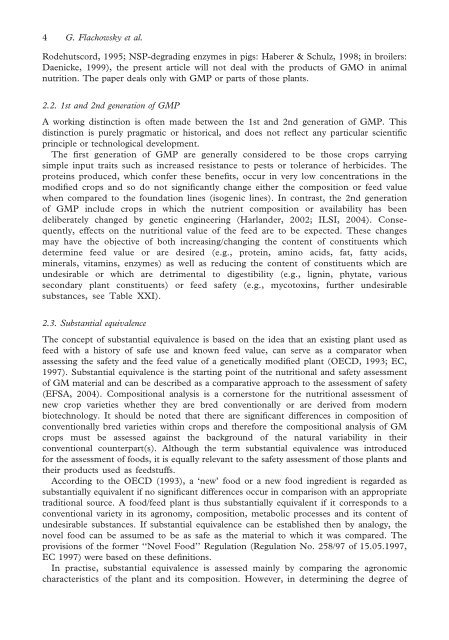Animal nutrition with feeds from genetically modified plants - Cib
Animal nutrition with feeds from genetically modified plants - Cib
Animal nutrition with feeds from genetically modified plants - Cib
You also want an ePaper? Increase the reach of your titles
YUMPU automatically turns print PDFs into web optimized ePapers that Google loves.
4 G. Flachowsky et al.<br />
Rodehutscord, 1995; NSP-degrading enzymes in pigs: Haberer & Schulz, 1998; in broilers:<br />
Daenicke, 1999), the present article will not deal <strong>with</strong> the products of GMO in animal<br />
<strong>nutrition</strong>. The paper deals only <strong>with</strong> GMP or parts of those <strong>plants</strong>.<br />
2.2. 1st and 2nd generation of GMP<br />
A working distinction is often made between the 1st and 2nd generation of GMP. This<br />
distinction is purely pragmatic or historical, and does not reflect any particular scientific<br />
principle or technological development.<br />
The first generation of GMP are generally considered to be those crops carrying<br />
simple input traits such as increased resistance to pests or tolerance of herbicides. The<br />
proteins produced, which confer these benefits, occur in very low concentrations in the<br />
<strong>modified</strong> crops and so do not significantly change either the composition or feed value<br />
when compared to the foundation lines (isogenic lines). In contrast, the 2nd generation<br />
of GMP include crops in which the nutrient composition or availability has been<br />
deliberately changed by genetic engineering (Harlander, 2002; ILSI, 2004). Consequently,<br />
effects on the <strong>nutrition</strong>al value of the feed are to be expected. These changes<br />
may have the objective of both increasing/changing the content of constituents which<br />
determine feed value or are desired (e.g., protein, amino acids, fat, fatty acids,<br />
minerals, vitamins, enzymes) as well as reducing the content of constituents which are<br />
undesirable or which are detrimental to digestibility (e.g., lignin, phytate, various<br />
secondary plant constituents) or feed safety (e.g., mycotoxins, further undesirable<br />
substances, see Table XXI).<br />
2.3. Substantial equivalence<br />
The concept of substantial equivalence is based on the idea that an existing plant used as<br />
feed <strong>with</strong> a history of safe use and known feed value, can serve as a comparator when<br />
assessing the safety and the feed value of a <strong>genetically</strong> <strong>modified</strong> plant (OECD, 1993; EC,<br />
1997). Substantial equivalence is the starting point of the <strong>nutrition</strong>al and safety assessment<br />
of GM material and can be described as a comparative approach to the assessment of safety<br />
(EFSA, 2004). Compositional analysis is a cornerstone for the <strong>nutrition</strong>al assessment of<br />
new crop varieties whether they are bred conventionally or are derived <strong>from</strong> modern<br />
biotechnology. It should be noted that there are significant differences in composition of<br />
conventionally bred varieties <strong>with</strong>in crops and therefore the compositional analysis of GM<br />
crops must be assessed against the background of the natural variability in their<br />
conventional counterpart(s). Although the term substantial equivalence was introduced<br />
for the assessment of foods, it is equally relevant to the safety assessment of those <strong>plants</strong> and<br />
their products used as <strong>feeds</strong>tuffs.<br />
According to the OECD (1993), a ‘new’ food or a new food ingredient is regarded as<br />
substantially equivalent if no significant differences occur in comparison <strong>with</strong> an appropriate<br />
traditional source. A food/feed plant is thus substantially equivalent if it corresponds to a<br />
conventional variety in its agronomy, composition, metabolic processes and its content of<br />
undesirable substances. If substantial equivalence can be established then by analogy, the<br />
novel food can be assumed to be as safe as the material to which it was compared. The<br />
provisions of the former ‘‘Novel Food’’ Regulation (Regulation No. 258/97 of 15.05.1997,<br />
EC 1997) were based on these definitions.<br />
In practise, substantial equivalence is assessed mainly by comparing the agronomic<br />
characteristics of the plant and its composition. However, in determining the degree of


